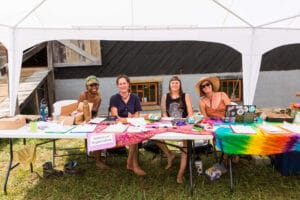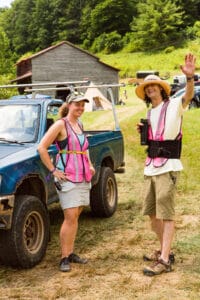Yesterday my partner and I laid in the grass in the burgeoning spring sunshine and napped. It was glorious! I put my face on the ground next to a tiny cluster of purple and white violets, breathed a sigh of joy, and wished hello to these lovely and nourishing little friends of early spring. For weeks I have been nibbling small snacks of chickweed every time I wander into the yard and delighting in the dark green fierceness of the nettle patches springing into abundance on the wild edges.
When is the last time you ate a plant right out of Earth? There is nothing like foraging for the wild foods that naturally, normally grow right under our feet to enhance our connection and appreciation for the abundant ways that nature supports our lives. Eating food that was grown without interrupting the soil or inserting our will into nature’s plan is so rare in modern culture and such a sublime blessing. Eating foraged food provides us with optimal nourishment, as these plants are so powerfully alive coming from their innate habitats and from soil that’s not been depleted from overuse with no loss of nutrients from storage or transport. Putting wild foods directly into our bodies straight from soil and Earth imbues us with the living energy of the world in addition to the high quantities of vitamins and minerals we take in with them.
Some of the most popular wild edibles that are ready to eat now in Western North Carolina (or will be soon) include violet, chickweed, nettles, dandelion, ramps, lambsquarter, daisy, and daylily, though there are many more!
As you look for wild plants to enjoy keep a few important things in mind:
- Though many wild edibles happily grow in the cracks of sidewalks and edges of roads, it is best not to eat plants that are likely exposed to toxic run-off from streets and highways. Avoid busy streets for foraging.
- Care for the populations of wild plants by only collecting small ratios of available plants and forage only in areas where there are populations of the plants that are abundant enough that other creatures can enjoy them, too, and always leave plenty behind for the plants to replicate themselves.
- Pull leaves and flowers, but not roots!
- Practice honorable harvesting. Before harvesting introduce yourself to the plants (yes, actually!) and ask their permission to collect from them. Listen with your entire self. The plants’ responses will come in subtle but clear ways if you practice and pay attention.
- Live in sacred reciprocity. What can you offer the plants in return for their generous gifts of energy, nourishment, and beauty?
If you are not sure yet what to look for there are amazing books to help you learn more about identifying the plants and their nutritional and medicinal value. Botany In a Day: The Patterns and Methods of Plant Identification by Thomas J. Elpel is an easy and helpful guide to making sure that you harvest appropriate plants and to learn important skills for being able to forage and know your way around the wild world of plants. A long-time favorite book of mine and a classic in herbal and wild food wisdom is Susun S. Weed’s Healing Wise, which gives in depth descriptions of the history and lore of several very important wild foods, including violet, chickweed, and nettles, plus great information on their nutritional components, medicinal uses, plus recipes!
Speaking of recipes, I want to share with you a recipe that has become a classic in my family. My youngest child has an April birthday, and she has come to expect nettle cupcakes as part of our yearly celebration of her springtime birth! This is my adaptation of a few other recipes to make it gluten-free and only containing natural, unrefined sweetener. Be aware that harvesting fresh nettles will most certainly expose you to the sting! You can mitigate that by wearing gloves when harvesting and when preparing the nettles to cook. But let me tell you that nettle sting is considered a powerful medicine, especially good for joint pain and reducing inflammation, so if you are brave enough and know the plant well, it can be amazing to harvest and prep with bare hands. I do it that way and consider it my spring tonic for supporting healthy joints in my hands. (WARNING: If you have never been stung by nettle before, for your safety, see what happens with just a small amount of sting before you expose yourself too much. Everyone is different and some may have more dramatic reactions than others.)
Early Spring Nettle Cupcakes
Ingredients:
3 pasture raised eggs
1 tsp vanilla
1 1/2 cups of maple syrup
approximately 4 cups of loose young nettle leaves (Enough raw nettles that you will end up with 1/2 cup when cooked and pureed.)
handful lemon balm (optional)
3/4 cup of olive or coconut oil
2 tbsp lemon juice
zest of 1 lemon (may save some of this if you will be making frosting)
2 cups sprouted oat flour
3 tsp baking powder
1/2 tsp salt
Directions:
Preheat oven to 350 degrees.
With or without gloves, rinse the nettles and pull leaves from stems. Discard stems (they make great compost!). If you are using lemon balm, rinse them, as well, but you may leave them intact.
Put nettles (and lemon balm) in a sauce pan and pour water over just to cover. Bring to simmering boil for at most 5 minutes. Drain well, cool, then puree. Add oil to ease pureeing process. (Coconut oil may need to be melted first if you opt to use it.)
Beat eggs and maple syrup until well mixed. Add vanilla, lemon juice, and nettle (plus lemon balm) puree. Mix well.
In a separate bowl whisk together flour, baking powder, and salt. Mix gently into the nettle lemon balm mixture until smooth.
Line muffin tins with baking cups. Fill ¾ with batter. Should make about 24 regular cupcakes or 12 large. Bake 25-30 minutes until firm and springy. Use toothpick or butter knife to test for doneness – should come out clean when inserted.
These cupcakes are moist and stand well on their own, but if you want to ice them try a natural, honey sweetened, buttercream or cream cheese frosting. (It’s easy to find recipes for those online!)





